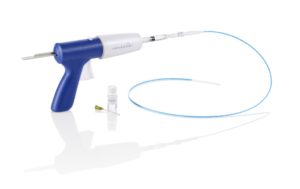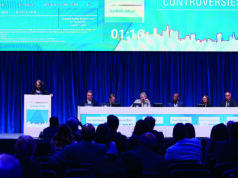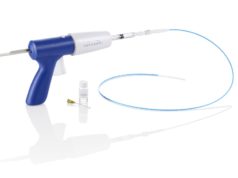 Three-year outcomes from the VeClose US pivotal clinical trial and one-year data from the WAVES study have been presented at the 2017 CX Symposium in London, UK. Both results were presented by Kathleen Gibson (Bellevue, USA). The new data demonstrate the clinical and quality of life benefits of the Medtronic VenaSeal closure system in treating patients with venous reflux disease.
Three-year outcomes from the VeClose US pivotal clinical trial and one-year data from the WAVES study have been presented at the 2017 CX Symposium in London, UK. Both results were presented by Kathleen Gibson (Bellevue, USA). The new data demonstrate the clinical and quality of life benefits of the Medtronic VenaSeal closure system in treating patients with venous reflux disease.
The VeClose US pivotal clinical trial is a prospective, randomised, controlled trial comparing the safety and effectiveness of the VenaSeal closure system to the Medtronic ClosureFast endovenous radiofrequency ablation procedure in a non-inferiority design. The trial enrolled 242 patients with symptomatic refluxing great saphenous veins, of which 222 were randomised 1:1 to receive treatment with VenaSeal or ClosureFast.
At three-years, the complete closure of the great saphenous vein was achieved in 94.4% of patients treated with VenaSeal compared to 91.9% of patients treated with ClosureFast—showing both the continued long-term, non-inferior outcomes (p=0.005) and the durability of the treatment.
Additionally, patient improvement was rated on three assessments: Venous Clinical Severity Score (VCSS), a clinical venous disease assessment; and the Aberdeen Varicose Vein Questionnaire (AVVQ) and EQ-5D. In all three assessments, patients treated with either VenaSeal or ClosureFast reflected statistically significant improvement from baseline.
“The three-year outcomes for this randomised trial reinforce the consistent clinical performance of VenaSeal and ClosureFast,” says Gibson. “These long-term VenaSeal data along with post-market WAVES study results continue to build on the prior findings for this innovative treatment option for venous reflux disease, demonstrating safety, effectiveness, and quality of life.”
One-year data from the independent, physician-initiated WAVES study, demonstrated quality of life impacts along with safety and effectiveness of the VenaSeal closure system. The single-centre study enrolled 50 patients in a real-world assessment of the treatment of one or more incompetent truncal veins in a single setting without mandatory post-operative compression stockings.
Key findings from the WAVES study are summarized as follows:
- The one-year great saphenous vein closure rate for VenaSeal was 100%. In comparison, the great saphenous vein closure rate for VenaSeal in VeClose, which required post-operative compression stockings, was 96.8%. Further, the mean vessel diameter in WAVES was larger than in VeClose.
- The mean time for patients’ return to work was 0.2 days ± 1.1 days. Furthermore, the mean time for returning to normal activities, including a patient’s exercise routine, was 2.4 days ± 4.1 days.












